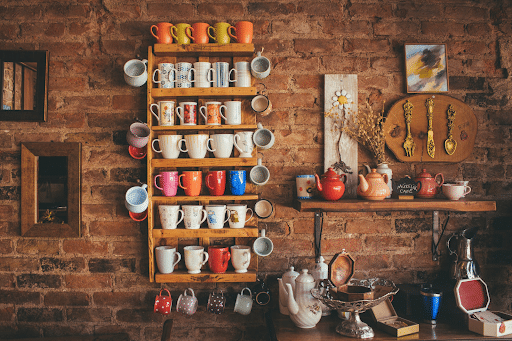When it comes to coffee, we’ve sometimes had to choose between quality and quantity. Batch brewing allows coffee shops, grocery stores, and large events to produce a lot of filtered coffee in a short amount of time.
But how does that coffee compare to, say, a third-wave cafe barista’s carefully heated and timed pour-over?
Historically, the flavor difference between batch brew and pour-over is like night and day. We’re here to tell you it doesn’t have to be that way. Old-school batch brewing is making a comeback, and here’s how to make yours taste great!
Pros & Cons of Batch Brewing Method vs. Pour-Over Brewing Method
At their core, batch brew and pour-over are actually the same method.
Wait, what now?
That’s right. They’re both methods that yield filter coffee; the big difference is that one process is automatic while the other has precise temperature and timing controls.
Pros of Manual Pour-Over Coffee
There’s a reason third-wave coffee shops put pour-overs on their menus. Pour-over allows you to adjust your coffee brewing methods to suit whatever coffee beans you use, so you can feature different roasters.
But that’s not all!
1. Pour-Over Coffee Gear is Affordable & Reliable
At least, more affordable than a high-quality batch brewer! It’s not susceptible to power outages (though your electric kettle is), and a pour-over won’t break down — necessitating costly repairs.
2. Pour-Over Provides a More Intimate Experience for Customers
You could watch someone quickly fill your cup of coffee from a giant urn or watch a barista painstakingly and lovingly pour, bloom, and time your precious single-origin purchase.
Aesthetics are one of the great joys in life, followed closely by rich coffee flavors!
3. Pour-Over Can Sometimes Taste Better
Because of the control baristas have over water flow, temperature, and timing, the end result and mouthfeel can be quite special.
Other Coffee Brewing Method Battles: French Press vs Moka Pot
Cons of Manual Pour-Over Coffee

We believe it was Pablo Picasso who said, “For every light roast there is a dark roast.” Wait…that’s not right; he said, “Every positive value has its price in negative terms….”
That got a little serious; these cons aren’t actually super negative.
1. Pour-Over Limits the Amount of Coffee You Can Make at One Time
This is a big issue when you’ve got a line of customers throughout and even waiting outside the coffee shop. If you’re short-staffed, the barista might even be having to bounce between drink-making and running a register.
If everyone orders those luscious single-origin pour-overs, there will be a long wait!
2. If the Barista is Busy, Pour-Over Quality/Flavor May Suffer
We talked about how pour-over is great because the brewer has complete control over the extraction and brew time. That goes out the window when the barista is too swamped to give a customer’s pour-over the attention it deserves.
Pros of Batch Brewing
Now that we’ve talked pour-over up let’s compare it to batch brewing.
1. Batch Brew is More Efficient
Starting with an obvious one, you can make larger batches of coffee, saving precious time when things get hectic. The batch brew is better for busier times when baristas can’t pay as much attention to making pour-over and need to check out other customers.
It’s relatively hands-off after you measure out the coffee into the filter.
2. Batch Brew is More Cost-Effective
Even though pour-over equipment like a Chemex is cheaper initially, batch brewing saves money long-term.
3. You Can Batch Brew Iced Coffee
Chill batch brew black coffee ahead of time and be ready for even the hottest days of summer.
Cons of Batch Brewing
There are two downsides that come to mind; one you may have seen coming because we listed it within one of the pros!
1. More Expensive Start-Up Costs
We’ll cover a few popular batch brewers and their prices in a later section, but manual brew equipment like Chemex or Aeropress is usually always under $50. You can expect a commercial batch brewer to range from several hundred to several thousand.
2. Potential Waste
So, you’ve brewed a nice large quantity of coffee. But what happens if it doesn’t all sell?
You could potentially chill some of it for iced coffee, but there will inevitably still be some waste in urns that only have a few cups of coffee left over in them.
How to Make Great Batch Brew Coffee
We’ve covered that manual brew gives you more control over the end result, so how can you ensure your batch brew is the highest quality?
Follow these tips for a better batch brewing experience!
How to Grind Beans for Batch Brew
Many batch brewers use a medium grind size, much like your standard at-home drip coffeemaker. It matters for different coffee brewing methods, including the Turkish coffee maker.
If you notice that your coffee is coming out a touch bitter, you may want to set your coffee grinder to output a slightly coarser grind.
Pre-ground coffee is convenient, but you should always grind your coffee beans directly before brewing for optimal taste.
Batch Brew Coffee Ratio
A good place to start is with a brew ratio of 60 grams of coffee to one liter of water. This works out to be ~14 grams per cup of coffee. Use a scale to get precise measurements.
Brew Time
Your batch brewer is automatic; you can’t input a desired brew time on all models (some you can!). However, how you load the coffee grounds and how deep the coffee bed is, which will affect how long it takes to brew (we’ll cover this in the next section!).
Brewing two liters of coffee should take about four and a half minutes.
Batch Coffee Brewing Step-by-Step Instructions
Get your coffee grounds and some paper filters, and head over to your batch brewer!
- Place a paper filter into the brew basket and rinse it with hot water. Allow the water to drain before proceeding to the next step.
- Weigh out 60 grams of coffee, then grind to medium-coarse.
- Load the coffee grounds into the filter and tap the brew basket to level the coffee bed. (Ideally, your coffee bed should have a depth of 2.5-5 centimeters.)
- If your batch brewer isn’t hooked up to its own water supply, then use this step to add fresh (preferably filtered water) to your brewer.
- Make sure the airpot or whatever you’re brewing into is in place and start the brew cycle.
- Once the brew is finished, give the carafe a quick swirl before you start serving cups of coffee.
Troubleshooting FAQs

Is your coffee still not turning out how you want? Check out these frequently asked questions.
Why Is My Batch Brew Weak and Watery?
This one is easy — not enough coffee! Increase your coffee measurement by five grams at a time until you’re happy with the result.
Batch Brew Coming Out Too Strong?
Do the opposite of the weak/watery tip: decrease your amount of coffee grams used by five grams at a time.
What If My Batch Brew is Bitter?
Probably it’s over-extracted; try coarsening up your grind size and see if the issue resolves.
My Batch Brew Tastes Sour?
Under Extraction is the culprit of sour coffee flavors. Adjust your grind size a bit finer.
Do You Need Specialty Coffee Beans for Batch Brew?
You’ll want to source freshly roasted coffee beans, but otherwise — no! No special beans are required (though a quality single-origin is always nice). Generally, espresso beans aren’t used for drip coffee, but there are no hard and fast rules there, just like at-home nitro cold brew.
Batch brew various roasts (light, medium, dark), a decaf option, and a flavored coffee or two and decant them into coffee urns. That way, you’ll have something on hand for every kind of coffee lover!
Find flavor inspiration here: 11 Best Flavored Coffees on the Market
How to Store Batch Brew Coffee to Keep it Fresh
Now that you’ve got a whole bunch of coffee on your hands, how can you keep it hot and fresh?
Answer: insulated air pots or carafes, of course!
Fortunately for you, we’ve got an article highlighting the 11 Best Coffee Urns to get you started.
Popular Batch Coffee Brewers
There are a lot of batch brewers; here are some popular options and their key features to help you narrow down what you want in a coffeemaker.
Fetco CBS-2132XTS Touchscreen Twin 1.0 Gal. Coffee Brewer
If your coffee shop is fairly high volume, you won’t regret investing in a twin brewer. Brew up to 11.5 gallons per hour with this Fetco model.
Key Features:
- Cascading spray dome
- Stainless steel finish (easy to clean!)
- Auto-stop if the brew basket is removed
- User-friendly touchscreen
- Free parts & labor warranty
You can find one-off websites like Webstaurant or Voltage Restaurant Supply. It typically costs between $1400-1500.
Bunn 53200.0100 ICB Infusion Twin Coffee Brewer
Bunn is a trusted name in the coffee supply industry. This twin brewer is programmable and comes with a free one-year warranty.
Key Features:
- Energy saver mode
- Separate hot water spigot
- Two batch size options and three brew buttons
- USB programming capable
- Made in America
It’s a little pricier than the Fetco on Voltage, going for $1900. However, they have a price match guarantee even if you find it somewhere else for cheaper and still want to order from them.
Wilbur Curtis G4 ThermoPro 1.0 Gal. Single Coffee Brewer
For a smaller operation that can get by with a single batch brewer rather than a twin, here’s one from Wilbur Curtis.
Key Features:
- Brews up to 7.5 gallons per hour
- A built-in self-diagnostic system
- Hot water spigot
- Large touchscreen w/ icon-based interface
- Free warranty
This brewer goes for $1800 on Voltage, but financing is available if needed.
Looking for a home brewer like the Moccamaster? Discover: The 7 Best Automatic Pour-Over Coffee Makers
Conclusion
That’s all, folks. We’ve covered every aspect of this hot caffeine topic (we hope).
Go forth and serve large quantities of high-quality batch brew to the public!


![How to Make Cowboy Coffee [Brew Guide]](https://caffeinecraze.com/wp-content/uploads/2023/01/errol-john-fegzFV9Lc4s-unsplash.jpg)

